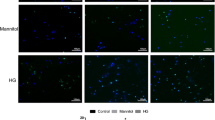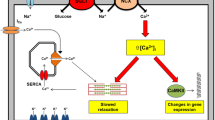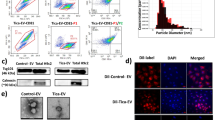Abstract
Purpose
Hypoglycemia in diabetes is a strong predictor of cardiovascular events. High-glucose have been reported to alter connexin43 expression and to promote autophagy in cardiomyocytes. We investigated whether low-after-high glucose would influence connexin43 expression and autophagy in H9c2 cells.
Methods
H9c2 cells were incubated in 33.3 mM glucose for 24 h followed by 2.5 mM glucose for 2, 4, 6, or 12 h with or without chloroquine (autophagy inhibitor), U0126 (MEK1/2 inhibitor) or LY294002 (PI3K inhibitor). Cells incubated in 5.5, 33.3, or 2.5 mM glucose with or without inhibitors and in the presence of mannitol were used as controls. Protein expression was assayed by western blot, apoptosis was assayed by flow cytometry, cell proliferation was determined by MTT assays, and cytotoxicity was assayed by lactate dehydrogenase measurement.
Results
Cytotoxicity and early apoptosis were increased and cell proliferation was decreased after exposure to low-after-high glucose, and these results were reversed by chloroquine and U0126 but were aggravated by LY294002. Connexin43 expression was downregulated in a time-dependent manner and was accompanied by upregulated expression of LC3-II, Beclin-1, p62, p-Akt, p-mTOR, and p-ERK1/2. Chloroquine suppressed autophagy and reversed the downregulation of connexin43. U0126 inhibited ERK activation and decreased autophagy proteins expression but increased connexin43 expression. LY294002 suppressed p-Akt, activated autophagy, and decreased connexin43 expression. Interestingly, MEK1/2 inhibition also increased p-Akt expression, but inhibition of PI3K led to p-ERK downregulation.
Conclusion
Culturing H9c2 cells under low-after-high glucose downregulated connexin43 by promoting autophagy through a mechanism involving the PI3K/Akt/mTOR and MEK/ERK1/2 signaling pathways.





Similar content being viewed by others
References
A.D. Mooradian, Cardiovascular disease in type 2 diabetes mellitus: current management guidelines. Arch. Intern. Med. 163(1), 33–40 (2003)
P. Zimmet, K.G. Alberti, J. Shaw, Global and societal implications of the diabetes epidemic. Nature 414(6865), 782–787 (2001). doi:10.1038/414782a.
Z.Y. Fang, J.B. Prins, T.H. Marwick, Diabetic cardiomyopathy: evidence, mechanisms, and therapeutic implications. Endocr. Rev. 25(4), 543–567 (2004). doi:10.1210/er.2003-0012.
S. Zoungas, A. Patel, J. Chalmers, B.E. de Galan, Q. Li, L. Billot, M. Woodward, T. Ninomiya, B. Neal, S. MacMahon, D.E. Grobbee, A.P. Kengne, M. Marre, S. Heller, Severe hypoglycemia and risks of vascular events and death. N. Eng. J. Med. 363(15), 1410–1418 (2010). doi:10.1056/NEJMoa1003795.
R.T. Robinson, N.D. Harris, R.H. Ireland, S. Lee, C. Newman, S.R. Heller, Mechanisms of abnormal cardiac repolarization during insulin-induced hypoglycemia. Diabetes 52(6), 1469–1474 (2003)
P. Dandona, A. Chaudhuri, S. Dhindsa, Proinflammatory and prothrombotic effects of hypoglycemia. Diabetes Care 33(7), 1686–1687 (2010). doi:10.2337/dc10-0503.
S. Mureli, C.P. Gans, D.J. Bare, D.L. Geenen, N.M. Kumar, K. Banach, Mesenchymal stem cells improve cardiac conduction by upregulation of connexin 43 through paracrine signaling. Am. J. Physiol. Heart. Circ. Physiol. 304(4), H600–609 (2013). doi:10.1152/ajpheart.00533.2012.
T. Desplantez, E. Dupont, N.J. Severs, R. Weingart, Gap junction channels and cardiac impulse propagation. J. Membr. Biol. 218(1–3), 13–28 (2007). doi:10.1007/s00232-007-9046-8.
T. Martins-Marques, S. Catarino, M. Zuzarte, C. Marques, P. Matafome, P. Pereira, H. Girao, Ischaemia-induced autophagy leads to degradation of gap junction protein connexin43 in cardiomyocytes. Biochem. J. 467(2), 231–245 (2015). doi:10.1042/bj20141370.
T. Martins-Marques, S. Catarino, C. Marques, P. Pereira, H. Girao, To beat or not to beat: degradation of Cx43 imposes the heart rhythm. Biochem. Soc. Trans. 43(3), 476–481 (2015). doi:10.1042/bst20150046.
G.G. Hesketh, M.H. Shah, V.L. Halperin, C.A. Cooke, F.G. Akar, T.E. Yen, D.A. Kass, C.E. Machamer, J.E. Van Eyk, G.F. Tomaselli, Ultrastructure and regulation of lateralized connexin43 in the failing heart. Circ. Res. 106(6), 1153–1163 (2010). doi:10.1161/circresaha.108.182147.
C.A. Rutledge, F.S. Ng, M.S. Sulkin, I.D. Greener, A.M. Sergeyenko, H. Liu, J. Gemel, E.C. Beyer, A.A. Sovari, I.R. Efimov, S.C. Dudley, c-Src kinase inhibition reduces arrhythmia inducibility and connexin43 dysregulation after myocardial infarction. J. Am. Coll. Cardiol. 63(9), 928–934 (2014). doi:10.1016/j.jacc.2013.10.081.
J. Radosinska, L.H. Kurahara, K. Hiraishi, C. Viczenczova, T. Egan Benova, B. Szeiffova Bacova, V. Dosenko, J. Navarova, B. Obsitnik, I. Imanaga, T. Soukup, N. Tribulova, Modulation of cardiac connexin-43 by omega-3 fatty acid ethyl-ester supplementation demonstrated in spontaneously diabetic rats. Physiol. Res. 64(6), 795–806 (2015)
Z. Anna, S. Angela, B. Barbara, R. Jana, B. Tamara, V. Csilla, D. Victor, M. Oleksiy, T. Narcisa, Heart-protective effect of n-3 PUFA demonstrated in a rat model of diabetic cardiomyopathy. Mol. Cell. Biochem. 389(1–2), 219–227 (2014). doi:10.1007/s11010-013-1943-9.
L. Yu, H. Yu, X. Li, C. Jin, Y. Zhao, S. Xu, X. Sheng, P38 MAPK/miR-1 are involved in the protective effect of EGCG in high glucose-induced Cx43 downregulation in neonatal rat cardiomyocytes. Cell. Biol. Int. (2016). doi:10.1002/cbin.10637.
L. Yu, Y. Zhao, Y. Fan, M. Wang, S. Xu, G. Fu, Epigallocatechin-3 gallate, a green tea catechin, attenuated the downregulation of the cardiac gap junction induced by high glucose in neonatal rat cardiomyocytes. Cell. Physiol. Biochem. 26(3), 403–412 (2010). doi:10.1159/000320564.
F.S. Hesari, N. Khajehnasiri, S.M. Khojasteh, F.G. Soufi, A. Dastranj, Attenuation of phosphorylated connexin-43 protein levels in diabetic rat heart by regular moderate exercise. Arch. Iran. Med. 17(8), 569–573 (2014). doi:aim.009/aim.009.
B. Levine, G. Kroemer, Autophagy in the pathogenesis of disease. Cell 132(1), 27–42 (2008). doi:10.1016/j.cell.2007.12.018.
J. Wang, M.W. Whiteman, H. Lian, G. Wang, A. Singh, D. Huang, T. Denmark, A non-canonical MEK/ERK signaling pathway regulates autophagy via regulating Beclin 1. J. Biol. Chem. 284(32), 21412–21424 (2009). doi:10.1074/jbc.M109.026013.
D.J. Klionsky, The molecular machinery of autophagy: unanswered questions. J. Cell. Sci. 118(Pt 1), 7–18 (2005). doi:10.1242/jcs.01620.
J.T. Fong, R.M. Kells, A.M. Gumpert, J.Y. Marzillier, M.W. Davidson, M.M. Falk, Internalized gap junctions are degraded by autophagy. Autophagy 8(5), 794–811 (2012). doi:10.4161/auto.19390.
N. Shinojima, T. Yokoyama, Y. Kondo, S. Kondo, Roles of the Akt/mTOR/p70S6K and ERK1/2 signaling pathways in curcumin-induced autophagy. Autophagy 3(6), 635–637 (2007).
A. Wang, H. Zhang, Z. Liang, K. Xu, W. Qiu, Y. Tian, H. Guo, J. Jia, E. Xing, R. Chen, Z. Xiang, J. Liu, U0126 attenuates ischemia/reperfusion-induced apoptosis and autophagy in myocardium through MEK/ERK/EGR-1 pathway. Eur. J. Pharmacol. 788, 280–285 (2016). doi:10.1016/j.ejphar.2016.06.038.
B. Roy, A.K. Pattanaik, J. Das, S.K. Bhutia, B. Behera, P. Singh, T.K. Maiti, Role of PI3K/Akt/mTOR and MEK/ERK pathway in Concanavalin A induced autophagy in HeLa cells. Chem. Biol. Interact. 210, 96–102 (2014). doi:10.1016/j.cbi.2014.01.003.
L. Yang, W. Guo, Q. Zhang, H. Li, X. Liu, Y. Yang, J. Zuo, W. Liu, Crosstalk between Raf/MEK/ERK and PI3K/AKT in suppression of Bax conformational change by Grp75 under glucose deprivation conditions. J. Mol. Biol. 414(5), 654–666 (2011). doi:10.1016/j.jmb.2011.09.009.
N. Martinez-Lopez, D. Athonvarangkul, P. Mishall, S. Sahu, R. Singh, Autophagy proteins regulate ERK phosphorylation. Nat. Commun. 4, 2799 (2013). doi:10.1038/ncomms3799.
A. Lichtenstein, P.J. Minogue, E.C. Beyer, V.M. Berthoud, Autophagy: a pathway that contributes to connexin degradation. J. Cell. Sci. 124(Pt 6), 910–920 (2011). doi:10.1242/jcs.073072.
M. Zalesak, P. Blazicek, I. Gablovsky, V. Ledvenyiova, M. Bartekova, A. Ziegelhoffer, T. Ravingerova, Impaired PI3K/Akt signaling as a potential cause of failure to precondition rat hearts under conditions of simulated hyperglycemia. Physiol. Res. 64(5), 633–641 (2015).
K. Chojnacka, M. Zarzycka, A. Hejmej, D.D. Mruk, E. Gorowska, M. Kotula-Balak, M. Klimek, B. Bilinska, Hydroxyflutamide affects connexin 43 via the activation of PI3K/Akt-dependent pathway but has no effect on the crosstalk between PI3K/Akt and ERK1/2 pathways at the Raf-1 kinase level in primary rat Sertoli cells. Toxicol. in vitro 31, 146–157 (2016). doi:10.1016/j.tiv.2015.09.027.
Y. Zhao, L. Yu, S. Xu, F. Qiu, Y. Fan, G. Fu, Down-regulation of connexin43 gap junction by serum deprivation in human endothelial cells was improved by (-)-Epigallocatechin gallate via ERK MAP kinase pathway. Biochem. Biophys. Res. Commun. 404(1), 217–222 (2011). doi:10.1016/j.bbrc.2010.11.096.
O.K. Mirzoeva, D. Das, L.M. Heiser, S. Bhattacharya, D. Siwak, R. Gendelman, N. Bayani, N.J. Wang, R.M. Neve, Y. Guan, Z. Hu, Z. Knight, H.S. Feiler, P. Gascard, B. Parvin, P.T. Spellman, K.M. Shokat, A.J. Wyrobek, M.J. Bissell, F. McCormick, W.L. Kuo, G.B. Mills, J.W. Gray, W.M. Korn, Basal subtype and MAPK/ERK kinase (MEK)-phosphoinositide 3-kinase feedback signaling determine susceptibility of breast cancer cells to MEK inhibition. Cancer Res. 69(2), 565–572 (2009). doi:10.1158/0008-5472.can-08-3389.
J. Zhou, T. Du, B. Li, Y. Rong, A. Verkhratsky, L. Peng, Crosstalk between MAPK/ERK and PI3K/AKT signal pathways during brain ischemia/reperfusion. ASN. Neuro. 7(5), (2015). doi:10.1177/1759091415602463.
S. Yu, X. Cai, C. Wu, L. Wu, Y. Wang, Y. Liu, Z. Yu, S. Qin, F. Ma, J.P. Thiery, L. Chen, Adhesion glycoprotein CD44 functions as an upstream regulator of a network connecting ERK, AKT and Hippo-YAP pathways in cancer progression. Oncotarget 6(5), 2951–2965 (2015). doi:10.18632/oncotarget.3095.
F. Zhang, T. Ding, L. Yu, Y. Zhong, H. Dai, M. Yan, Dexmedetomidine protects against oxygen-glucose deprivation-induced injury through the I2 imidazoline receptor-PI3K/AKT pathway in rat C6 glioma cells. J. Pharm. Pharmacol. 64(1), 120–127 (2012). doi:10.1111/j.2042-7158.2011.01382.x.
J. DeSalvo, J.N. Kuznetsov, J. Du, G.M. Leclerc, G.J. Leclerc, T.J. Lampidis, J.C. Barredo, Inhibition of Akt potentiates 2-DG-induced apoptosis via downregulation of UPR in acute lymphoblastic leukemia. Mol. Cancer Res. 10(7), 969–978 (2012). doi:10.1158/1541-7786.mcr-12-0125.
Acknowledgements
This study was funded by the Shanghai Committee of Science and Technology, China (grant No. 13ZR1431500).
Author information
Authors and Affiliations
Corresponding author
Ethics declarations
Conflict of interest
The authors declare that they have no competing interest.
Ethical approval
This article does not contain any studies with human participants performed by any of the authors.
Electronic supplementary material
Rights and permissions
About this article
Cite this article
Bi, Y., Wang, G., Liu, X. et al. Low-after-high glucose down-regulated Cx43 in H9c2 cells by autophagy activation via cross-regulation by the PI3K/Akt/mTOR and MEK/ERK1/2 signal pathways. Endocrine 56, 336–345 (2017). https://doi.org/10.1007/s12020-017-1251-3
Received:
Accepted:
Published:
Issue Date:
DOI: https://doi.org/10.1007/s12020-017-1251-3




